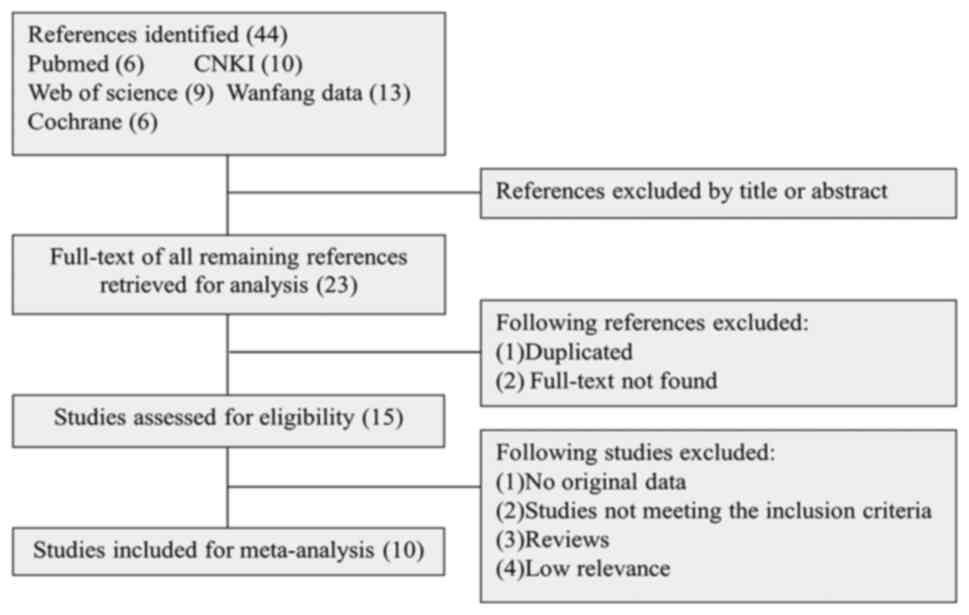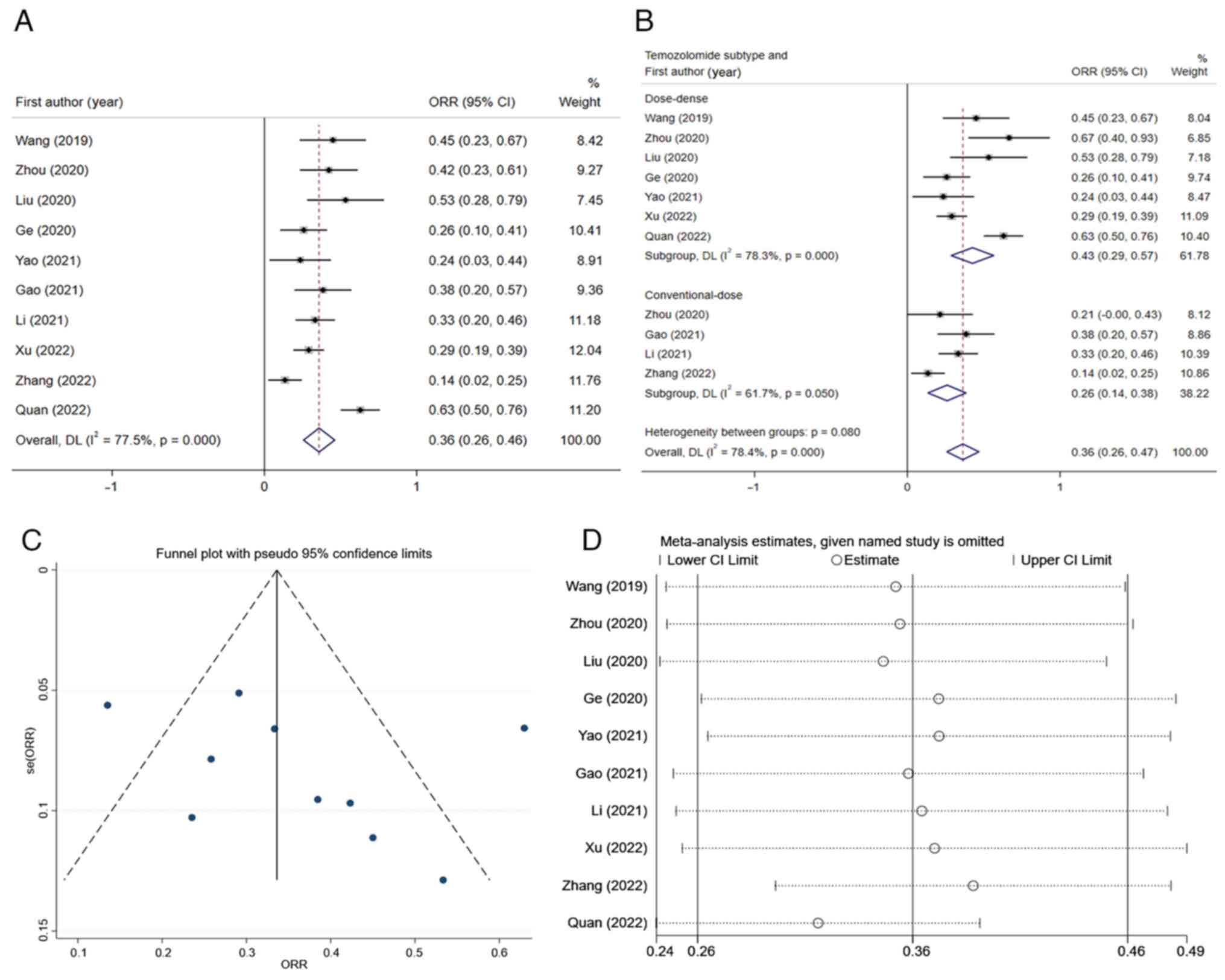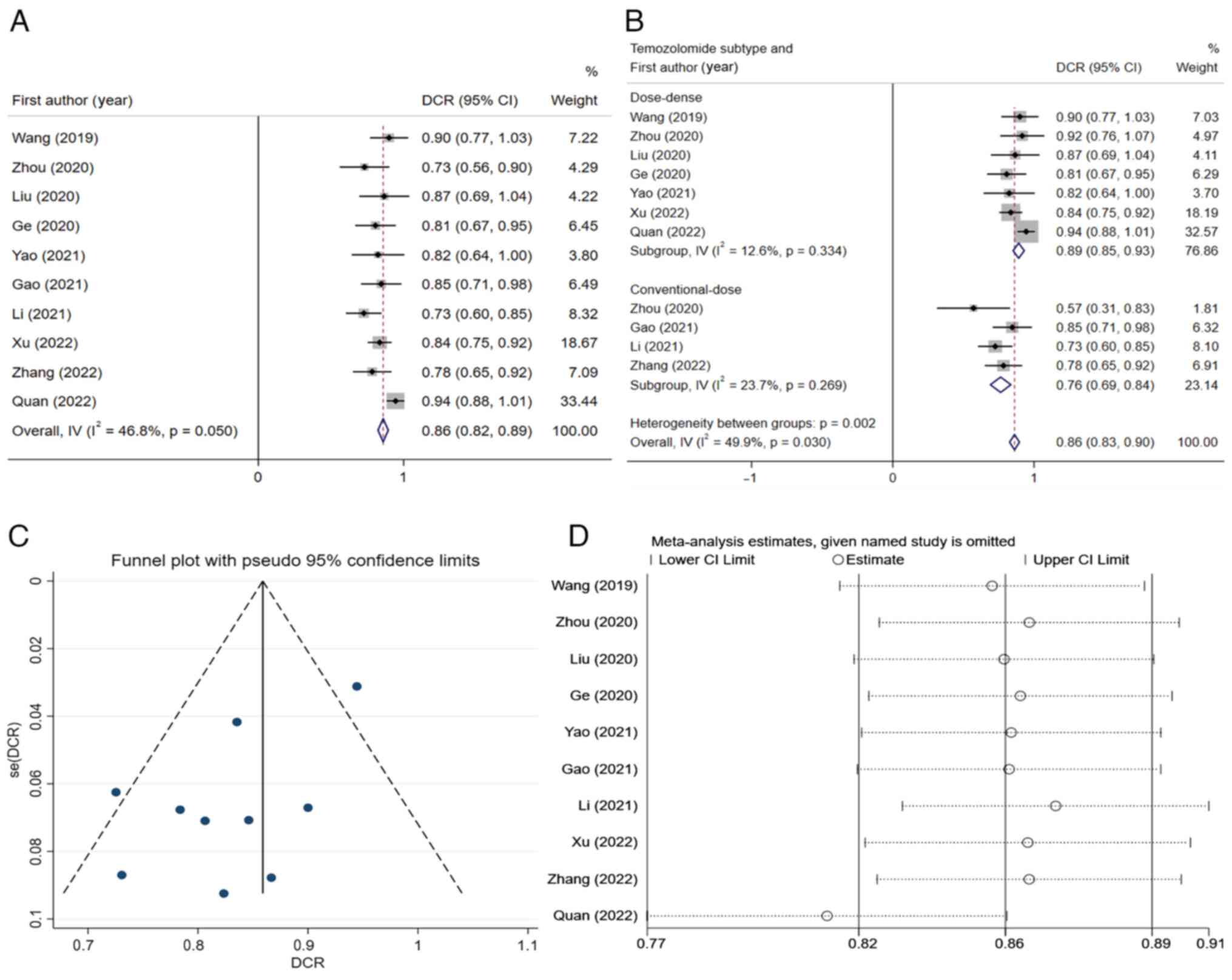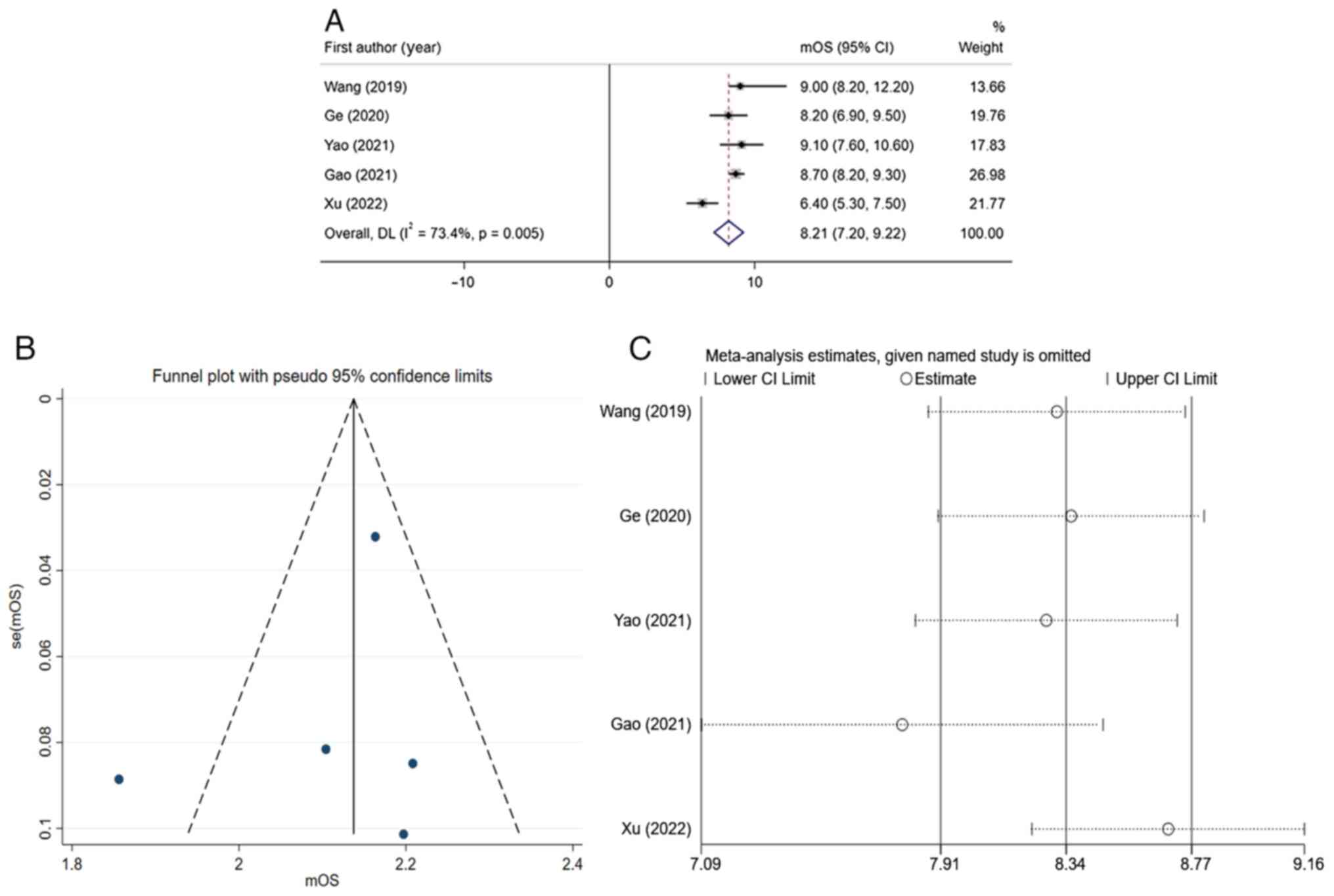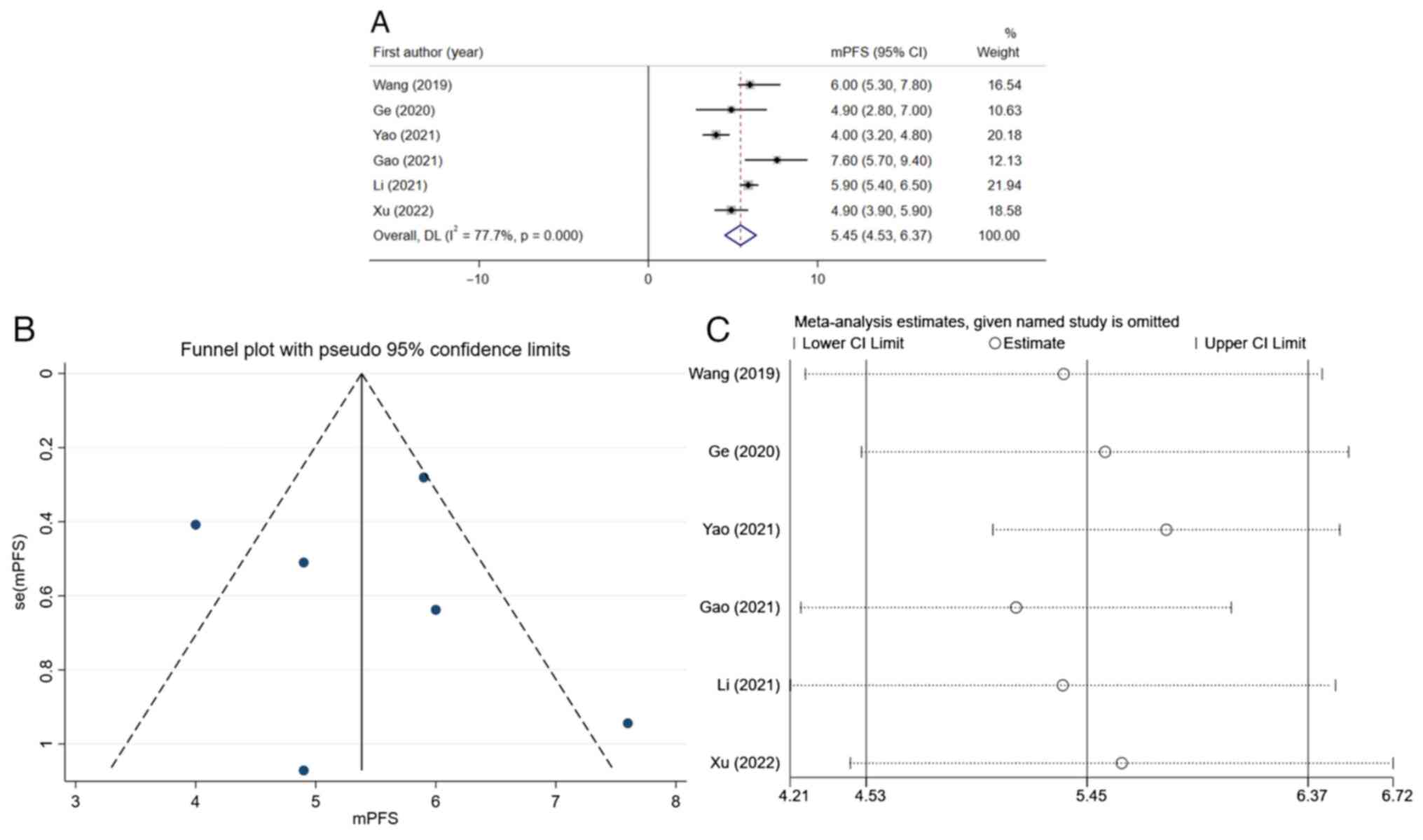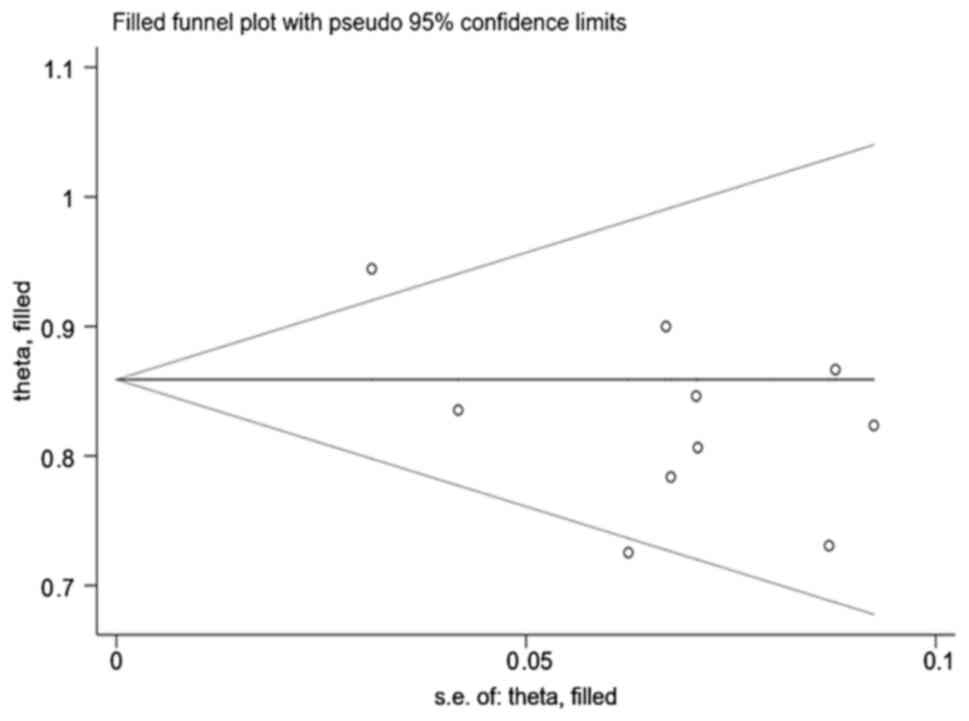|
1
|
Wu H, Deng Z, Wang H, Li X, Sun T, Tao Z,
Yao L, Jin Y, Wang X, Yang L, et al: MGMT autoantibodies as a
potential prediction of recurrence and treatment response biomarker
for glioma patients. Cancer Med. 8:4359–4369. 2019.PubMed/NCBI View Article : Google Scholar
|
|
2
|
Stupp R, Mason WP, van den Bent MJ, Weller
M, Fisher B, Taphoorn MJB, Belanger K, Brandes A, Marosi C, Bogdahn
U, et al: Radiotherapy plus concomitant and adjuvant temozolomide
for glioblastoma. N Engl J Med. 352:987–996. 2005.PubMed/NCBI View Article : Google Scholar
|
|
3
|
Hervey-Jumper SL and Berger MS:
Reoperation for recurrent high-grade glioma: A current perspective
of the literature. Neurosurgery. 75:491–499. 2014.PubMed/NCBI View Article : Google Scholar
|
|
4
|
Stupp R, Wong ET, Kanner AA, Steinberg D,
Engelhard H, Heidecke V, Kirson ED, Taillibert S, Liebermann F,
Dbalý V, et al: NovoTTF-100A versus physician's choice chemotherapy
in recurrent glioblastoma: A randomized phase Ⅲ trial of a novel
treatment modality. Eur J Cancer. 48:2192–2202. 2012.PubMed/NCBI View Article : Google Scholar
|
|
5
|
Lang FF, Conrad C, Gomez-Manzano C, Yung
WKA, Sawaya R, Weinberg JS, Prabhu SS, Rao G, Fuller GN, Aldape KD,
et al: Phase I study of DNX-2401(Delta-24-RGD) oncolytic
adenovirus: Replication and immunotherapeutic effects in recurrent
malignant glioma. J Clin Oncol. 36:1419–1427. 2018.PubMed/NCBI View Article : Google Scholar
|
|
6
|
Tuettenberg J, Friedel C and Vajkoczy P:
Angiogenesis in malignant glioma-a target for antitumor therapy?
Crit Rev Oncol Hematol. 59:181–193. 2006.PubMed/NCBI View Article : Google Scholar
|
|
7
|
Rainer E, Wang H, Traub-Weidinger T,
Widhalm G, Fueger B, Chang J, Zhu Z, Marosi C, Haug A, Hacker M and
Li S: The prognostic value of [123I]-vascular
endothelial growth factor ([123I]-VEGF) in glioma. Eur J
Nucl Med Mol Imaging. 45:2396–2403. 2018.PubMed/NCBI View Article : Google Scholar
|
|
8
|
Kreisl TN, Kim L, Moore K, Duic P, Royce
C, Stroud I, Garren N, Mackey M, Butman JA, Camphausen K, et al:
Phase Ⅱ trial of single-agent bevacizumab followed by bevacizumab
plus irinotecan at tumor progression in recurrent glioblastoma. J
Clin Oncol. 27:740–745. 2009.PubMed/NCBI View Article : Google Scholar
|
|
9
|
Liang Q, Kong L, Du Y, Zhu X and Tian J:
Antitumorigenic and antiangiogenic efficacy of apatinib in liver
cancer evaluated by multimodality molecular imaging. Exp Mol Med.
51:1–11. 2019.PubMed/NCBI View Article : Google Scholar
|
|
10
|
Wang C, Jiang M, Hou H, Lin Q, Yan Z and
Zhang X: Apatinib suppresses cell growth and metastasis and
promotes antitumor activity of temozolomide in glioma. Oncol Lett.
16:5607–5614. 2018.PubMed/NCBI View Article : Google Scholar
|
|
11
|
Li J, Qin S, Xu J, Xiong J, Wu C, Bai Y,
Liu W, Tong J, Liu Y, Xu R, et al: Randomized, double-blind,
Placebo-controlled phase III trial of Apatinib in patients with
chemotherapy-refractory advanced or metastatic adenocarcinoma of
the stomach or Gastroesophageal junction. J Clin Oncol.
34:1448–1454. 2016.PubMed/NCBI View Article : Google Scholar
|
|
12
|
Zhang L, Shi M, Huang C, Liu X, Xiong JP,
Liu GC, Liu W, Zhang Y, LI K, Yu H and Jiang H: A phase II,
multicenter, placebo-controlled trial of apatinib in patients with
advanced nonsquamous non-small cell lung cancer (NSCLC) after two
previous treatment regimens. J Clin Oncol. 30
(15_suppl)(7548)2012.
|
|
13
|
Hu X, Cao J, Hu W, Wu C, Pan Y, Cai L,
Tong Z, Wang S, Li J, Wang Z, et al: Multicenter phase II study of
apatinib in non-triple-negative metastatic breast cancer. BMC
Cancer. 14(820)2014.PubMed/NCBI View Article : Google Scholar
|
|
14
|
Wang Y, Meng X, Zhou S, Zhu Y, Xu J and
Tao R: Apatinib plus temozolomide for recurrent glioblastoma: An
uncontrolled, open-label study. Onco Targets Ther. 12:10579–10585.
2019.PubMed/NCBI View Article : Google Scholar
|
|
15
|
Zhou PC, Pan HH, Liang TS and Yang DK:
Short-term efficacy of apatinib combined with dose-dense
temozolomide in treatment of recurrent malignant glioma after
postoperative chemoradiotherapy. J Med Forum. 41:73–79. 2020.(In
Chinese).
|
|
16
|
Ge J, Li C, Xue F, Qi S, Gao Z, Yu C and
Zhang J: Apatinib plus Temozolomide: An effective salvage treatment
for recurrent glioblastoma. Front Oncol. 10(601175)2021.PubMed/NCBI View Article : Google Scholar
|
|
17
|
Wei W, Chen X, Ma XM, Wang D and Guo Z:
The efficacy and safety of various dose-dense regimens of
temozolomide for recurrent high-grade glioma: A systematic review
with meta-analysis. J Neurooncol. 125:339–349. 2015.PubMed/NCBI View Article : Google Scholar
|
|
18
|
Page MJ, McKenzie JE, Bossuyt PM, Boutron
I, Hoffmann TC, Mulrow CD, Shamseer L, Tetzlaff JM, Akl EA, Brennan
SE, et al: The PRISMA 2020 statement: An updated guideline for
reporting systematic reviews. BMJ. 372(n71)2021.PubMed/NCBI View
Article : Google Scholar
|
|
19
|
Higgins JPT, Thompson SG, Deeks JJ and
Altman DG: Measuring inconsistency in meta-analyses. BMJ.
327:557–560. 2003.PubMed/NCBI View Article : Google Scholar
|
|
20
|
Egger M, Smith GD, Schneider M and Minder
C: Bias in meta-analysis detected by a simple, graphical test. BMJ.
315:629–634. 1997.PubMed/NCBI View Article : Google Scholar
|
|
21
|
Liu ZJ, Sun HW, Song ZY, Guo S, Gao M,
Zhou G and Liu X: Apatinib combined with dose-dense temozolomide in
the treatment of recurrent malignant glioma. Chin J Pract Nerv Dis.
23:958–962. 2020.(In Chinese).
|
|
22
|
Yao H, Liu JG, Zhang C, Shao Y, Li X, Feng
M, Wang X, Gan W, Zhou Y and Huang Y: Clinical study of apatinib
plus temozolomide for the treatment of recurrent high-grade
gliomas. J Clin Neurosci. 90:82–88. 2021.PubMed/NCBI View Article : Google Scholar
|
|
23
|
Gao M, Li MY, Ma QQ, Shi H and Yang Y:
Brucea javanica oil emulsion combined with apatinib and
temozolomide in the treatment of recurrent high-grade glioma. J
Basic Clin Oncol. 34:36–40. 2021.(In Chinese).
|
|
24
|
Li TY, Hai L, Wu H, Hong X, Lu X and Sun
X: Clinical research of apatinib in the treatment of durg-resistant
recurrent glioblastoma. Chin J Clin Oncol. 48:619–623. 2021.(In
Chinese).
|
|
25
|
Xu KY, Jiao Y, Wang JK, Liu X, Sun H, Luo
W and Zhao H: Effect of apatinib combined with temozolomide in the
treatment of recurrent high-grade glioma. Henan J Surgery.
28:30–32. 2022.(In Chinese).
|
|
26
|
Zhang M, Gao LY, Liu X, Dong F, Su Q,
Zhang Y, Li F, Wang H and Han P: Low-dose Apatinib improves the
prognosis of patients with recurrent high-grade gliomas. Evid Based
Complement Alternat Med. 2022(3181133)2022.PubMed/NCBI View Article : Google Scholar
|
|
27
|
Quan LL, Song HB and Song LL: Short term
and long-term efficacy of bevacizumab monoclonal antibody and
apatinib combined with temozolomide in treatment of recurrent
high-grade glioma. Chin J Mod Med. 32:11–15. 2022.(In Chinese).
|
|
28
|
Ostrom QT, Cioffi G, Gittleman H, Patil N,
Waite K, Kruchko C and Barnholtz-Sloan JS: CBTRUS statistical
report: Primary brain and other central nervous system tumors
diagnosed in the United States in 2012-2016. Neuro Oncol. 21 (Suppl
5):v1–v100. 2019.PubMed/NCBI View Article : Google Scholar
|
|
29
|
Wick W, Weller M, Van den bent M, Sanson
M, Weiler M, von Deimling A, Plass C, Hegi M, Platten M,
Reifenberger G, et al: MGMT testing-the challenges for
biomarker-based glioma treatment. Nat Rev Neurol. 10:372–385.
2014.PubMed/NCBI View Article : Google Scholar
|
|
30
|
Nabors LB, Portnow J, Ahluwalia M,
Baehring J, Brem H, Brem S, Butowski N, Campian JL, Clark SW,
Fabiano AJ, et al: Central nervous system cancers, version 3.2020,
NCCN clinical practice guidelines in oncology. J Natl Compr Canc
Netw. 18:1537–1570. 2020.PubMed/NCBI View Article : Google Scholar
|
|
31
|
Jain HV, Nör JE and Jackson TL: Modeling
the VEGF-Bcl-2-CXCL8 pathway in intratumoral agiogenesis. Bull Math
Biol. 70:89–117. 2008.PubMed/NCBI View Article : Google Scholar
|
|
32
|
Peng S, Zhang Y, Peng H, Ke Z, Xu L, Su T,
Tsung A, Tohme S, Huang H, Zhang Q, et al: Intracellular autocrine
VEGF signaling promotes EBDC cell proliferation, which can be
inhibited by Apatinib. Cancer Lett. 373:193–202. 2016.PubMed/NCBI View Article : Google Scholar
|
|
33
|
Peng H, Zhang Q, Li J, Zhang N, Hua Y, Xu
L, Deng Y, Lai J, Peng Z, Peng B, et al: Apatinib inhibits VEGF
signaling and promotes apoptosis in intrahepatic
cholangiocarcinoma. Oncotarget. 7:17220–17229. 2016.PubMed/NCBI View Article : Google Scholar
|
|
34
|
Tong XZ, Wang F, Liang S, Zhang X, He JH,
Chen XG, Liang YG, Mi YJ, To KKW and Fu LW: Apatinib (YN968D1)
enhances the efficacy of conventional chemotherapeutical drugs in
side population cells and ABCB1-overexpressing leukemia cells.
Biochem Pharmacol. 83:586–597. 2012.PubMed/NCBI View Article : Google Scholar
|
|
35
|
Roviello G, Ravelli A, Fiaschi AI,
Cappelletti MR, Gobbi A, Senti C, Zanotti L, Polom K, Reynolds AR,
Fox SB and Generali D: Apatinib for the treatment of gastric
cancer. Expert Rev Gastroenterol Hepatol. 10:887–892.
2016.PubMed/NCBI View Article : Google Scholar
|
|
36
|
Duerinck J, Clement PM, Bouttens F, Andre
C, Neyns B, Staelens Y, Fraeyenhove FV, Baurain JF, Luce S, D'hondt
L, et al: Patient outcome in the Belgian medical need program on
bevacizumab for recurrent glioblastoma. J Neurol. 262:742–751.
2015.PubMed/NCBI View Article : Google Scholar
|
|
37
|
Verhoeff JJC, Lavini C, van Linde ME,
Stalpers LJA, Majoie CBLM, Reijneveld JC, van Furth WR and Richel
DJ: Bevacizumab and dose-intense temozolomide in recurrent
high-grade glioma. Ann Oncol. 21:1723–1727. 2010.PubMed/NCBI View Article : Google Scholar
|
|
38
|
Gilbert MR, Pugh SL, Aldape K, Sorensen
AG, Mikkelsen T, Penas-Prado M, Bokstein F, Kwok Y, Lee RJ and
Mehta M: NRG oncology RTOG 0625: A randomized phase II trial of
bevacizumab with either irinotecan or dose-dense temozolomide in
recurrent glioblastoma. J Neurooncol. 131:193–199. 2017.PubMed/NCBI View Article : Google Scholar
|



